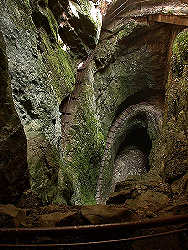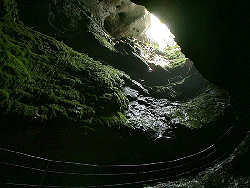Dimnice Jama
Smoke Cave
Useful Information

| Location: | 23 km southeast of Trieste. |
| Open: |
Every Sun at 15:30. [2007] |
| Fee: |
Adult 750 SIT. [2003] |
| Classification: |
 Karst Cave.
Turonian limestone. Karst Cave.
Turonian limestone.
|
| Light: |
 Carbide Lamps Carbide Lamps
 LED LED
|
| Dimension: | L=6,020 m, D=134 m, A=567 m asl. |
| Guided tours: | D=90 min, VR=105 m. |
| Photography: | |
| Accessibility: | |
| Bibliography: |
Sandro Sedran (2006):
Speleo Per Tutti,
Escusioni in facili grotte del nord-est italiano e Slovenia / Proposte per un nuovo tipo di escursionismo e spunti di accompagnamento per i gruppi speleologici
256 pp, 265 colour photos, ISBN 8889562099.
EUR 19, published by the author: Sandro Sedran, Via Nazionale 259/5, 30034 Mira, (VE), Italy
E-mail: |
| Address: |
Jamarsko drutvo Dimnice (Caving Club Dimnice), p.p. 74, 66000 Koper.
Warden: Franci Maleèkar, Premanèan 28, 6280 Ankaran, Tel: +386-66-526036, Cell: +386-41-693014. |
| As far as we know this information was accurate when it was published (see years in brackets), but may have changed since then. Please check rates and details directly with the companies in question if you need more recent info. |
|
History
| 1904 | first exploration of the cave by A. R. Penck. |
Description

Dimnice Jama is a rather young show cave, among so many historic show caves, which were visited for hundreds of years. The name Dimnice Jama (Smoke Cave) refers to the fog which came out of two big holes in the ground during winter. It was known to the locals for a long time because of the fog, but never entered, as it lacked an easy entrance. The first time it was explored was in 1904, when A. R. Penck, the later manager of Postojnska Jama, was doing research for drinking water supply. He was the first who had the skills and equipment to descent through one of the vertical daylight shafts.
Today one of the shafts is developed with a path winding around the shaft along the wall, a ledge which was cut into the vertical wall almost one metre wide and two meters high. This spiral staircase is one of the most impressive sights of the cave and very popular with photographers. Once down the 39 m deep entrance pit, the cave visitor has reached a horizontal passage of impressive dimensions, some 20 m wide and high. This passage connects both entrances, and has various chambers with enormous speleothems. Right at the bottom of the entrance is a huge chamber with level floor, which is called Dancing Hall and was used as such.
From the Dancing Hall the tourist paths leads down the White Chamber, a huge passage or chamber with a steep floor. The path goes down in zigzag, around huge stalagmites which are up to 22 m high, to the deepest point of the cave.
At a depth of 105 m the lower level of the cave is reached. A comparably small river passage, which ends at both sides with an sump. The water of the cave river was used as drinking water. Originally A. R. Penck explored the cave to find this water. But the technical difficulties were too big to use it at this time. It was used by the Germans during World War II, who built a small pump house right beneath the cave river and pumped the water up for their soldiers. The front was at this time running through the karst nearby. After the war the locals took all the remains with them and only a concrete platform remains today of the pump shed.
It was never a good idea to use the water of this cave river. In general karst water stays too short in the ground to be cleaned by microorganisms. So the water is very sensitive to any pollution above and generally not suitable for drinking water. In this case its even worse: the source of the water are nearby Brkini Hills, an area of soft undulating flysch rocks. The rain water drains on the surface in dozens of small rivers to the south. When the water reaches the limestone of Matarsko Podolje it forms short blind valleys and then completely sinks into the karst. The river in the Dimnice cave runs only 500 m through a river cave, so its quality is exactly the same as that of the river outside. Also the amount of water changes over the year, there is only a period of one to two months when the river has sufficient water. The rest of the year the underground river stands in its bed and a little pumping empties it.
There is also a middle level of the cave. The white chamber is toured anticlockwise, and when going up the path on the right side about half up a horizontal passage branches off. This passage is extremely well decorated, the dripstones form pillars, curtains, and walls. The passage crosses a flat depression where the floor is covered by a thick layer of red clay. At one point the path crosses an area of small rimstone pools or gours. It has a size of probably 10 by 10 meters, and as the pools cover the whole floor area it is necessary to walk across. At one place there is a chamber of decent size, which is completely formed by flowstone walls, in other words, it is a small chamber in the big passage formed by speleothems. There is only a small gap in the flowstone wakk to slide through.

|
| Dimnice Jama Gallery |
 Search DuckDuckGo for "Dimnice Jama"
Search DuckDuckGo for "Dimnice Jama" Google Earth Placemark
Google Earth Placemark Jama Dimnice, official website. (
Jama Dimnice, official website. (
 )
) Index
Index Topics
Topics Hierarchical
Hierarchical Countries
Countries Maps
Maps